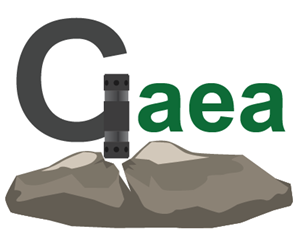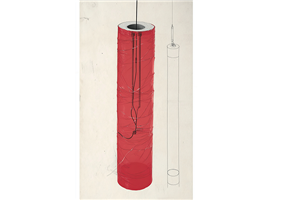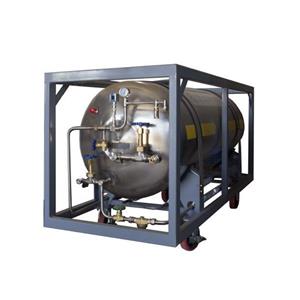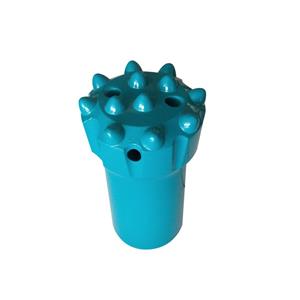Impact drill rod introduce
When selecting a drill rod for an impact rock drill, mining engineers face many factors to consider, including rod diameter, cross-sectional shape, drill steel type and heat treatment process. The selection is not only affected by technical conditions, but also by regional preferences and market availability.
There are two basic types of drill rods currently produced: the first is with a forged drill tail, and the second is with threads at each end. The first is suitable for integral, tapered or threaded drill heads. The second is used in the case of a drill tail, such as a single drill rod for a rail-type rock drill, or a rod assembly drill rod connected to a threaded rod sleeve.
Drill Steel Types
Hollow drill steel is hot-rolled from a steel billet with a round center full metal core into a round or hexagonal cross-section and different lengths. The chemical composition of the steel must be well selected and accurately controlled to make it suitable for the type of drill rod required and the heat treatment method used. After rolling to the required size, it is stretched to reduce the diameter and then the metal core is removed.
High carbon steel containing 1% carbon and 1% chromium, and a small amount of manganese and molybdenum, has strong fatigue resistance and can be locally heat treated and welded. They are used to make drill rods with drill tails, including integral drill rods.
The high-frequency quenching process involves rapidly heating the workpiece to 900°C and then rapidly cooling it in water. This changes the metal structure and also causes compressive stress on the surface. The high-frequency method can be used to locally heat treat the cone, drill tail and thread, making the drill rod flexible and able to withstand large bending and rough operations. Sandblasting is a cold work hardening process that removes surface defects and prolongs life.
Low and medium carbon steel containing 0.2~0.27% carbon, 2~3% chromium or nickel, and manganese or molybdenum is used to make extension rods, extension rod tails, extension rod sleeves and drill bit bodies. They are generally fully carburized. During carburization, a bundle of 200~300 drill rods is suspended in a cage and treated in a carbon-rich atmosphere at 925°C in a pit furnace for about 6 hours. Due to carburization, the basic chemical composition and properties of the outer layer change, causing volume increase and compressive stress. This process occurs over the entire surface, including the internal flushing holes, improving the durability, fatigue strength, hardness and stiffness of the drill rod, as well as its wear and corrosion resistance. When wet drilling, it is naturally important to improve wear and corrosion resistance in order to protect the flushing holes. It is reported that about 95% of the connecting rod parts used for wet drilling in underground wells are carburized as a whole, including the connecting rod sleeve and the drill bit thread. When this type of steel is partially carburized, it is difficult to perform local annealing because "annealing" zones will be formed.
It is a technically difficult process to weld carbide sheets in carburized steel to make integral drills, but some manufacturers have achieved success. The heavy-duty integral drill rods they produce are used in high-power rock drills for mechanized rock drilling. It is reported that their service life is three times that of high-carbon steel, such as 900 meters versus 300 meters.
Another low-carbon alloy steel has particularly good machinability. It contains nickel and chromium. Generally, this steel is also carburized as a whole. Medium carbon (0.42%) carbon chromium-nickel steel is used by some factories to make long heavy-duty integral drill rods.
The outer surface and flushing holes can be phosphated to prevent rust. A protective wax coating can also be applied during storage. Corrosion and rust can cause premature fatigue cracks.
When drilling abrasive hard rock with a wet rock drill, fully carburized drill rods are generally preferred. However, when drilling rock on open-pit steps with joints or broken rock formations, the drill rod is in danger of serious bending, and the carburized drill rod may be broken. High-frequency quenching drill rods can better adapt to this situation. Because high-frequency quenching drill rods have greater toughness, they are not easily damaged by impact caused by accidental or intentional impacts, and they are also not easily damaged by loose threads caused by insufficient propulsion force, which causes local heating and damage. Compressed air purging may also cause local heating and surface erosion. High-frequency quenching drill rods are not prone to this phenomenon, but they are prone to thread wear.
When the borehole is shallow, say below 6 meters, or as the borehole deepens, a set of drill rods of different lengths is used, or a single drill equal to the depth of the borehole is used, which is widely used today. This type of drill rod is forged with a drill tail. The drill head is either integral with the drill rod or a movable drill head connected by a cone or thread. Drill rods with a drill tail are made of hexagonal drill steel with opposite side dimensions of 19mm, 22mm or 25mm, and are used for hand-held rock drills, air-leg rock drills and mechanized drilling vehicles for drilling holes in working faces or rock bolts. As mentioned above, this type of drill rod is generally made of high-carbon chromium-containing alloy steel. This alloy steel can withstand bending without breaking or permanent deformation.
The end of the drill tail (if the drill rod is not fully carburized) is quenched separately to withstand the impact stresses caused by the piston and the rotating torque. If the drill head is connected by a cone, it can also be heat treated separately. The overall drill rod structure should make the total wear life of tungsten carbide equal to the fatigue life of the drill rod. However, this approach is unrealistic in highly abrasive rocks, and it is better to use a live drill head.
For mechanized rock drilling that uses high-pressure water to flush rock cuttings, the drill rod should be equipped with a drill tail seal to prevent the flushing water from entering the rock drill, because for pneumatic rock drills, this situation may affect lubrication and cause ice.
At least one manufacturer provides an overall drill rod with a ball tooth drill head instead of a slotted drill head. An overall drill rod with a cross drill head is suitable for broken or fractured rocks, because there is a risk of drill bit pinching when drilling in these rocks. Nevertheless, the slotted drill head has the outstanding advantage of being easy to grind.
Connector drill tail
When using a connecting rod to drill deep holes, the connecting rod drill tail is inserted into the drill tail sleeve of the rock drill, and the connecting rod sleeve is connected to the first drill rod in the drill rod group. Since the rock drills manufactured by the rock drill manufacturer have drill sleeves of various structures, there are many types of connecting rod drill tails. The simplest is the hexagonal shouldered shank, others vary in complexity, with bosses or splines.
The shank must transfer the impact energy, rotational torque and thrust to the drill rod, and its rear face, threads and splines or shank must have high wear resistance. The shock wave generated by the piston propagates at the speed of sound in steel (about 5000 m/s) and a frequency of 60 times/s. Small displacements occur at the threaded connection, and the wear caused must be minimized by wear-resistant steel, which has the characteristics of becoming brittle but not losing fatigue strength. The most suitable steel is low-carbon chromium steel or nickel-chromium steel, and the common heat treatment is full carburization.
When drilling shallow holes, it is better to connect a shank drill and a live drill bit for a rail-type rock drill after the shank than to use a single shank with a shank, especially when drilling large-diameter blastholes in hard rock and using high-power rock drills. This method allows the replacement of the adapter, adapter sleeve, drill rod and drill head when necessary. However, since the adapter sleeve passes through an open drill holder, there is a disadvantage that the extension length is lost, which is equivalent to the length of the adapter.
When drilling a step-down blasthole, the first section of the drill rod must be disconnected from the adapter before adding the adapter. With the adapter sleeve, it is possible for it to fall off, so it is sometimes preferred to use an adapter with internal threads. Unless all female threads are used, the adapter sleeve is connected to the lower end of the drill rod. Compared with the use of the adapter sleeve, a more rigid connection is formed between the drill adapter and the first drill rod. If large bending stresses are caused in the drill adapter due to the blasthole deflection, the rigid connection is more likely to be damaged.
There is a "slender" transition section between the tail of the drill adapter and the threaded part, which is said to make the drill adapter elastic and able to withstand bending stresses.
The flushing medium (water or compressed air) enters the blasthole through the water needle of the rock drill or an independent rotating device. When flushing with high-pressure water (more than 8 bar), an independent rotating device must be used. Modern hydraulic rock drills have an integral purge system at the end of the drill tail sleeve.
Connecting rods
Deep hole rock drilling rods are made of chromium-molybdenum steel containing 2-3% chromium or nickel and can be hexagonal or round. The diameter of the rod body and the threaded part of the large-section drill rod is the same, while the diameter of the threaded end of the light drill rod is larger. Although the lighter drill rod has the risk of deflection of the blasthole due to the reduced rigidity, it is more convenient to use light drill rods when drilling upward. Light drill rods require complex forging processes, and carburizing is the basic method to obtain higher fatigue strength.
Round drill rods with a diameter of more than 32mm are used for drilling deep holes on heavy drilling vehicles. When connecting and unloading heavy drill rods for deep holes, use effective auxiliary devices to mechanize the connection and unloading of drill rods.
Threads
There are four basic constructions of threads for rock drill rods: "R" or wave thread, "T" or trapezoidal thread, "C" or double-start thread, and "Hi-Leed" or reverse serration thread (Figure 1). The "T" thread was developed by Sandvik and can be produced by other manufacturers under license from Sandvik, but in most cases it is marked with other symbols. The entire thread must be manufactured to high precision tolerances and have a high surface finish.
Image
The "R" thread has a constant thread angle of 20° measured from the axis of the rod and a constant pitch of 0.5 inches. It is used for small-size rods with diameters from 22mm to 28mm. For high-powered rock drills, it is possible to overtighten the "R" thread, the degree of tightening depending on the impact energy, rotational torque, and the resistance generated by the rock and the thrust.
Compared with the "R" thread, the "T" thread has a larger thread angle and its pitch increases with increasing diameter. It has the characteristics of balanced tightness and is used for drill rods with diameters of 38mm and 45mm. "C" thread is suitable for larger equipment, such as drill rods with diameters of 51mm or 57mm. It has double-start threads and its thread profile angle is similar to that of "T" thread. "Hi-Leed" thread tooth profile is sawtooth-shaped, and its connection and disassembly performance is between "R" and "T*" threads. It is used for drill rods with diameters between 25mm and 57mm, and its thread angle size is between "R" and "T" threads.
When rock drilling is easier, the threaded section on the connecting rod can be made twice as long, so that when the first section of the thread is worn, it can be cut off, but special attention should be paid when cutting off to avoid local heating and tempering of the drill rod. In some cases, the drill rod has reached its fatigue life after the thread is worn. The choice of single-start or double-start thread is determined by the inspection trial of the rock drill and rock conditions, but the thrust is an important parameter.
Ingersoll-Rand ( Ingersoll-Rand has made a special thread that is threaded along the entire length of the drill rod, so when one end of the thread is worn, it can be cut off and then chamfered and reused. It is reported that its life is increased by 5 times compared with drill rods with threads only on the ends. The threads are rolled, which has high shear strength, and the surface is hardened, so it is tough and wear-resistant. It uses a fairly steep helix angle so that it can be loosened with minimal torque. Its specifications are 32mm, 38mm and 44mm.
Drill rod improvement
05
A new generation of impact rock drills, special Especially hydraulically powered rock drills, which can win in many aspects of open-pit rock drilling in competition with rotary drills and down-the-hole drills. These advances occurred simultaneously with the improvement of drill rods and drill bits. As the drilling speed increases, the drill rod must have greater toughness and is usually heavier. Obviously, the handling device and automatic control of heavy drill rods are very important and are necessary auxiliary equipment.
The life of the drill rod is mainly affected by the amplitude of the stress wave, so long stress waves with small amplitude and uniform distribution are the most favorable. Hydraulic impact rock drills produce this kind of wave. Compared with the short and thick piston of the pneumatic rock drill, Its piston diameter is small and long. It is estimated that it is possible to save 15% in the cost of drill rod consumption by using hydraulic rock drills. Another favorable factor is that the power of the rock drill can be adjusted relatively easily according to the matching of rock drilling speed and drill rod cost. In addition, the use of automatic eye opening and anti-jamming devices can also prevent or at least minimize the occurrence of drill jamming.
It is estimated that the basic investment accounts for 25~30% of the rock drilling cost, spare parts and maintenance account for 22~33%, wages account for 12~25%, energy consumption accounts for 2~6%, and drill rods and drill bits account for 20~22%. Among the above expenses, the differences between mines are The difference is very large. However, if the total cost of drilling the ore is $2/ton, the cost of the drill rod and drill bit is $0.4/ton. If the drill often breaks during drilling, it will increase costs and delay time. In large mines, even a small saving in the consumption of drill bits and drill rods can have considerable benefits. In order to minimize costs, it is very important to discuss with the drill rod manufacturer and carefully select the drill rod according to the production and use conditions.
Maintenance of drill rods
06
Drilling machine ensures that the drill tail sleeve is intact and the drill head is sharp.
Turn the connecting rod around and use the drill rods in the drill rod group in turn to make the threads in the drill rod group wear evenly. Use the connecting rod sleeve according to the corresponding life of the drill rod thread-new connecting rod sleeve with new drill rod.
When dry drilling, clean and lubricate the threads with special grease, and only use straight drill rods. Heating the drill rod before starting in cold weather conditions will extend its life.
Drill carefully and use 1/4~1/2 of the power of the rock drill when drilling. If the drill rod is not aligned, it needs to be re-drilled.
Use the best thrust. Too much thrust will cause the rod to bend and shorten its life, and can also block the drill head purge hole and cause the drill head carbide plate to wear or damage; insufficient thrust will cause heating at the connection, damage the connection, excessive wear or loosening of the drill head carbide plate.
The rod sleeve "snaps" against the drill holder, which will damage the rod sleeve.
Ensure flushing means that there is always enough flushing water to quickly remove the rock chips.
Be careful to withdraw the drill-use 1/4 of the thrust speed when withdrawing the drill to prevent the drill from getting stuck.
Use a good wrench to remove the drill rod. Hammering or using a pipe clamp will damage the hardened surface. Pitfalls can cause fatigue fractures. Use a special gauge to measure the wear of the threads on the rod sleeve and the drill rod. When the wear exceeds the specified limit, it must be scrapped.
Storage If it is to be stored after use, it must be treated with a rust inhibitor and not piled near water or dust. Corrosion is a big problem in underground mines.





